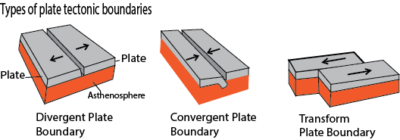
Types of plate tectonic boundaries

There are three types of Plate tectonic boundaries
- A divergent boundary(constructive plate boundary/margin) occurs when two tectonic plates move away from each other widening the gap between the plates. Along these boundaries, earthquakes are common and magma (molten rock) rises from the Earth’s mantle to the surface, solidifying to create new oceanic crust. Examples include divergent tectonic boundaries include The Mid-Atlantic Ridge.
- A convergent boundary occurs when two plates come together narrowing the gap between the plates. The impact of the colliding plates can cause the edges of one or both plates to buckle up into a mountain ranges or one of the plates may bend down into a deep seafloor trench. A chain of volcanoes often forms parallel to convergent plate boundaries and powerful earthquakes are common along these boundaries. The Pacific Ring of Fire is an example of a convergent plate boundary.
At convergent plate boundaries, oceanic crust is often forced down into the mantle where it begins to melt. Magma rises into and through the other plate, solidifying into granite, the rock that makes up the continents. Thus, at convergent boundaries, continental crust is created and oceanic crust is destroyed.
- A transform plate boundary (transform plate margin) occurs when two plates sliding parallel past each other. One of the most famous transform plate boundaries occurs at the San Andreas fault zone, which extends underwater.
Natural or human-made structures that cross a transform boundary are offset — split into pieces and carried in opposite directions. Rocks that line the boundary are pulverized as the plates grind along, creating a linear fault valley or undersea canyon. Earthquakes are common along these faults. In contrast to convergent and divergent boundaries, crust is cracked and broken at transform margins, but is not created or destroyed.


It is perfect time to make some plans for the future and it is time to be happy I’ve read this post and if I could I desire to suggest you some interesting things or advice Maybe you could write next articles referring to this article I want to read even more things about it!
Your blog is a source of inspiration for me. Computer & Accessories
Your content is consistently great. Barcelona News
Fast-track your admission to leading colleges via MBBS Admission Through Management/Nri Quota in Andhra Pradesh.
Discover cutoff marks for admission at MBBS Cutoff Of Private Medical Colleges in Telangana.
Raja Luck is your go-to platform for exciting and rewarding gaming experiences.